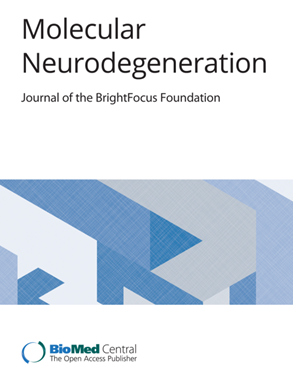人类神经元中Tau单体和聚集体摄取和细胞内积累的独特调控
IF 14.9
1区 医学
Q1 NEUROSCIENCES
引用次数: 0
摘要
朊病毒样的Tau病理扩散是各种Tau病疾病进展的主要原因。病理Tau蛋白在大脑中传播的一个关键步骤是细胞外环境的转运和naïve神经元内的积累。目前的研究表明,人类神经元内化生理性细胞外Tau (eTau)单体和病理性eTau聚集物。然而,Tau物种之间神经元转运机制的相似性或差异性仍然难以捉摸。合成了重组2N4R Tau的单体、低聚物和原纤维,并通过生化和生物物理方法对其进行了表征。建立了人诱导多能干细胞衍生神经元(iPSCNs)和Lund人中脑细胞(LUHMES)衍生神经元的神经元eTau摄取和积累试验。利用小分子内吞机制抑制剂和靶向Tau摄取介质的sirna,研究了eTau物种的摄取和细胞积累机制。细胞外Tau聚集体在人类神经元中的积累多于单体,主要是由于小纤维和可溶性低聚物聚集体在神经元内积累的效率更高。竞争分析揭示了生理eTau单体和病理相关聚集体在神经元积累方面的区别,表明不同的运输机制。用肝素阻断硫酸肝素蛋白聚糖(HSPGs)仅抑制eTau聚集体的积累,而单体的摄取保持不变。在分子水平上,参与HSPG合成的基因的下调只会阻止eTau聚集体的神经元积累,而不会阻止单体的积累,这表明它在病理性Tau的运输中起作用。此外,LRP1作为Tau的受体,其下调主要减少了单体形式的积累,证实了其参与Tau的生理运输。这些数据表明,尽管细胞机制相似,但人类神经元中eTau单体和聚集体的摄取和积累受到不同分子介质的调节。因此,他们解决了在不干扰Tau单体可能的生理或非致病性运输的情况下靶向Tau聚集体病理扩散的可能性。本文章由计算机程序翻译,如有差异,请以英文原文为准。
Distinct regulation of Tau Monomer and aggregate uptake and intracellular accumulation in human neurons
The prion-like spreading of Tau pathology is the leading cause of disease progression in various tauopathies. A critical step in propagating pathologic Tau in the brain is the transport from the extracellular environment and accumulation inside naïve neurons. Current research indicates that human neurons internalize both the physiological extracellular Tau (eTau) monomers and the pathological eTau aggregates. However, similarities or differences in neuronal transport mechanisms between Tau species remain elusive. Monomers, oligomers, and fibrils of recombinant 2N4R Tau were produced and characterized by biochemical and biophysical methods. A neuronal eTau uptake and accumulation assay was developed for human induced pluripotent stem cell-derived neurons (iPSCNs) and Lund human mesencephalic cells (LUHMES)-derived neurons. Mechanisms of uptake and cellular accumulation of eTau species were studied by using small molecule inhibitors of endocytic mechanisms and siRNAs targeting Tau uptake mediators. Extracellular Tau aggregates accumulated more than monomers in human neurons, mainly due to the higher efficiency of small fibrillar and soluble oligomeric aggregates in intraneuronal accumulation. A competition assay revealed a distinction in the neuronal accumulation between physiological eTau Monomers and pathology-relevant aggregates, suggesting differential transport mechanisms. Blocking heparan sulfate proteoglycans (HSPGs) with heparin only inhibited the accumulation of eTau aggregates, whereas monomers’ uptake remained unaltered. At the molecular level, the downregulation of genes involved in HSPG synthesis exclusively blocked neuronal accumulation of eTau aggregates but not monomers, suggesting its role in the transport of pathologic Tau. Moreover, the knockdown of LRP1, as a receptor of Tau, mainly reduced the accumulation of monomeric form, confirming its involvement in Tau’s physiological transport. These data propose that despite the similarity in the cellular mechanism, the uptake and accumulation of eTau Monomers and aggregates in human neurons are regulated by different molecular mediators. Thus, they address the possibility of targeting the pathological spreading of Tau aggregates without disturbing the probable physiological or non-pathogenic transport of Tau Monomers.
求助全文
通过发布文献求助,成功后即可免费获取论文全文。
去求助
来源期刊

Molecular Neurodegeneration
医学-神经科学
CiteScore
23.00
自引率
4.60%
发文量
78
审稿时长
6-12 weeks
期刊介绍:
Molecular Neurodegeneration, an open-access, peer-reviewed journal, comprehensively covers neurodegeneration research at the molecular and cellular levels.
Neurodegenerative diseases, such as Alzheimer's, Parkinson's, Huntington's, and prion diseases, fall under its purview. These disorders, often linked to advanced aging and characterized by varying degrees of dementia, pose a significant public health concern with the growing aging population. Recent strides in understanding the molecular and cellular mechanisms of these neurodegenerative disorders offer valuable insights into their pathogenesis.
 求助内容:
求助内容: 应助结果提醒方式:
应助结果提醒方式:


